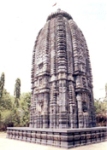Khiching
 An ancient capital of the Bhanja rulers, Khiching is located about 205 km from Balasore and 150 km from Baripada in the Mayurbhanj district of north Orissa. A center of art and architecture the area has several exquisite temples and monuments. It was a major center of civilization around the 8th to 12th centuries AD.
The ruins of the ancient glorious town are visible from present village from the bank of the Khairabandhan River in the north to the Kantakhair River in the south. It experienced varied cultural influences and liaisons. The art of Khiching expressed the aesthetic and religious sensibilities along with an individuality of its own.
An ancient capital of the Bhanja rulers, Khiching is located about 205 km from Balasore and 150 km from Baripada in the Mayurbhanj district of north Orissa. A center of art and architecture the area has several exquisite temples and monuments. It was a major center of civilization around the 8th to 12th centuries AD.
The ruins of the ancient glorious town are visible from present village from the bank of the Khairabandhan River in the north to the Kantakhair River in the south. It experienced varied cultural influences and liaisons. The art of Khiching expressed the aesthetic and religious sensibilities along with an individuality of its own.
Khiching had a group of eight temples dedicated to Lord Shiva with the lingams of the seven temples visible. Three ancient temples are dedicated to Kutaitundi, Chandrasekhar and Kichakeswari. One can also see the ruins of the forts of Viratgarh and Kichakagarh, few stupas and several sculptures. The largest temple of the town is dedicated to Goddess Kichakeswari, the family goddess of the ruling chiefs of Mayurbhanj. The chlorite temple is well carved from its outer surface.
The temple has a large ten-armed skeletal image of Chamunda with striking veins, ribs and sunken belly, wearing a garland of skulls and seated over a dead body.One can see the Parasvadevatas, the Chaitya arches, the amorous couples, the scroll works on the temple.
The ruins of two fortified palaces of Khiching are magnificent. The Kichakagarh Fort named after the well-known character in the Mahabharata were probably the royal residences of the Bhanja rulers. Viratgarh site has unearthed number of antiquities such as pottery, terracotta figurines, stone images, beads, pieces of gold and seals. The discovery of a Kushana coin places the history of the region to the 2nd century AD. Chaula Kunji also known as the Natya-Mandir is located to the southwest of the present Khiching temple with 14 monolith pillars.
A brick mound called Itamundia situated to the southeast of the Kichakeswari temple complex has a massive image of the Buddha. The most noteworthy discovery from this place is the carved bricks, which formed the wall of the main temple. An image of the Buddha enshrined in the lower part of the temple was found during the excavation.
The laterite stone temple has two images of Uma-Maheswara on the banks of the river Kantakhair.One can visit the museum at Khiching, which has the life-size images of Durga, Ganesha, Parsvanatha, Tara, Parvati, Ardhanageswar, Vaishnavi, Nandi, Kartikeya, Avalokiteswar, Dhyani Buddha, Mahishasuramardini, Uma-Maheswara and female devotees on display. There are other exhibits like the copper and iron implements, terracotta figurines, seals, ornaments, potteries, coins, stone tools and various fragments of the temples.
One of the highest points of the Orissan sculpture tradition the monuments of Khiching represent aesthetic sense with exquisite craftsmanship. The temple and sculptures are built in blue fine-grained chlorite an enduring stone with qualities for elaborate ornamentation.
Some of the Major Architecture in Ancient & Medieval Times in India
Contribute More Facts